The Ultimate Guide to Popular Japanese Sweets & Desserts
Do you have a sweet tooth like I do? If so you’re in the right place! In this Japan food guide, you’ll find several traditional Japanese sweets like taiyaki, a fish-shaped cake with bean paste, dango, chewy rice flour dumplings, and other types of wagashi as well as the infamous Harajuku crepes, and a plethora of Japanese ice cream options. One thing is for sure, you are going to LOVE these popular Japanese sweets and desserts!
Melon Pan (メロンパン)
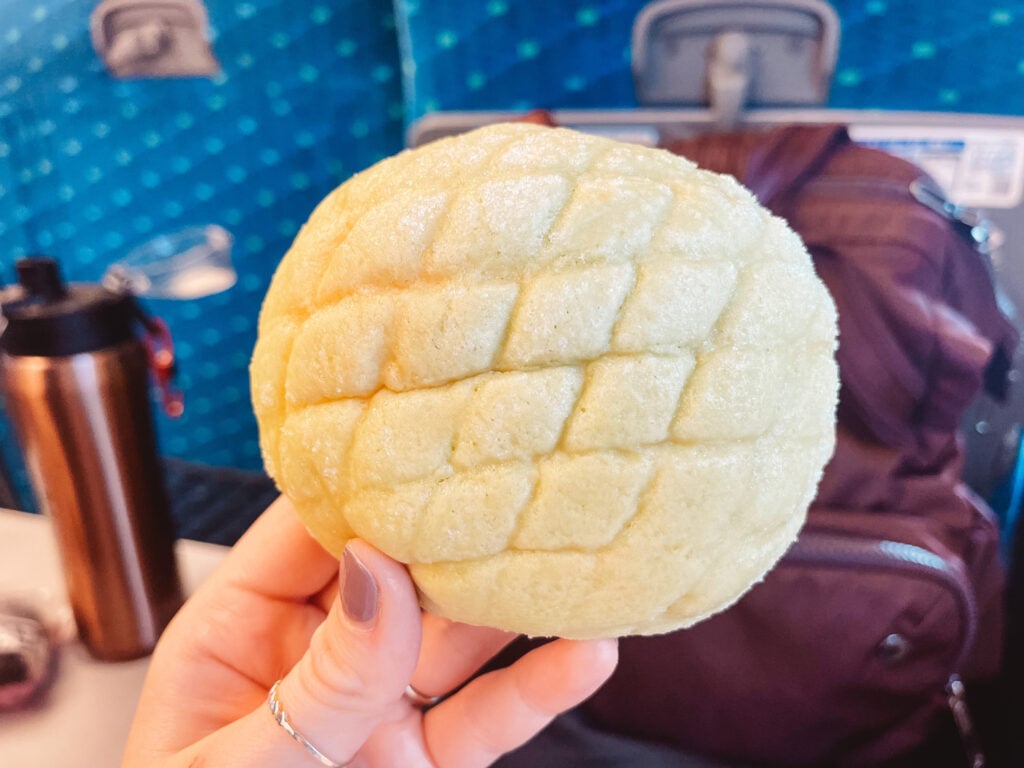
The first popular Japanese sweet I want to talk about is one of my favorites, melon pan. I love melon pan so much that I recently spent 5 hours kneading, proofing, and making it at home because I couldn’t let go of a craving for it!
Melon pan is a sweet bread that is made with two layers. The bottom is an enriched dough that, when baked, is similar to a regular bread bun but a touch sweeter. The top is crisp, cookie-like dough covered in sugar. Though the name is melon pan there is actually no melon in this dessert. It got its name because its appearance is similar to a cantaloupe!
Most melon pan is made with two kinds of dough but some have chocolate chips, some that are filled with custard, ones that resemble animal faces, and even melon pan ice cream sandwiches!


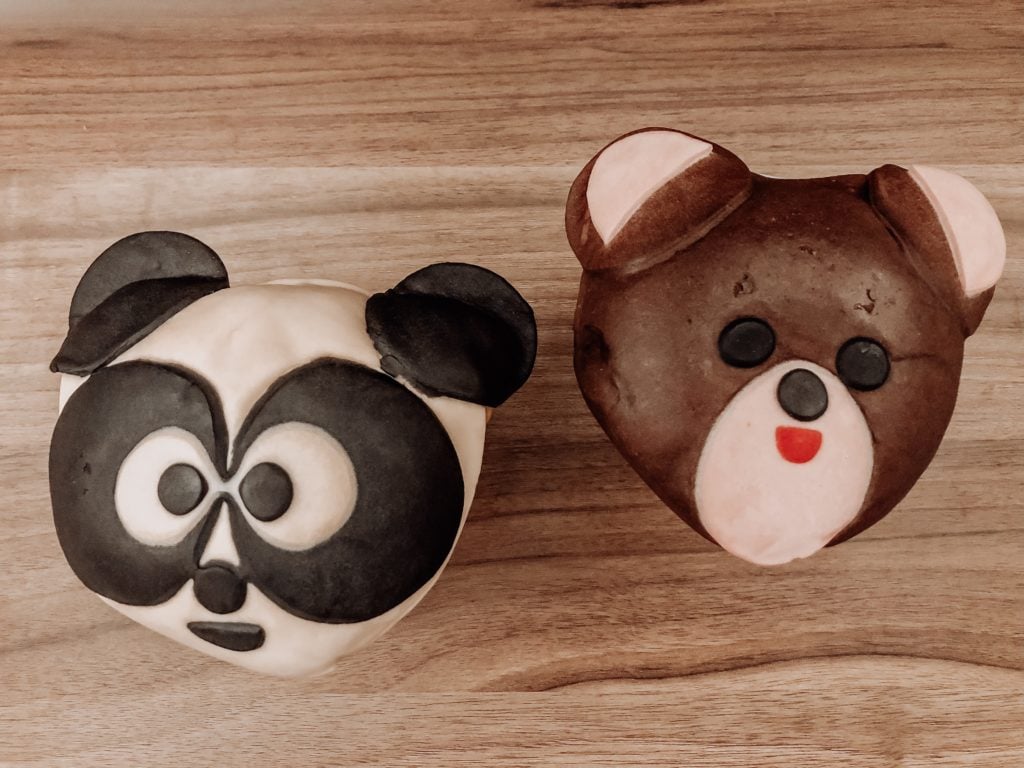
WHERE TO TRY MELON PAN IN JAPAN
- Kagetsudo – Tokyo (Asakusa)
- Konbini (convenience stores) – 7-Eleven, Lawson, & FamilyMart
Donuts (ドーナツ)
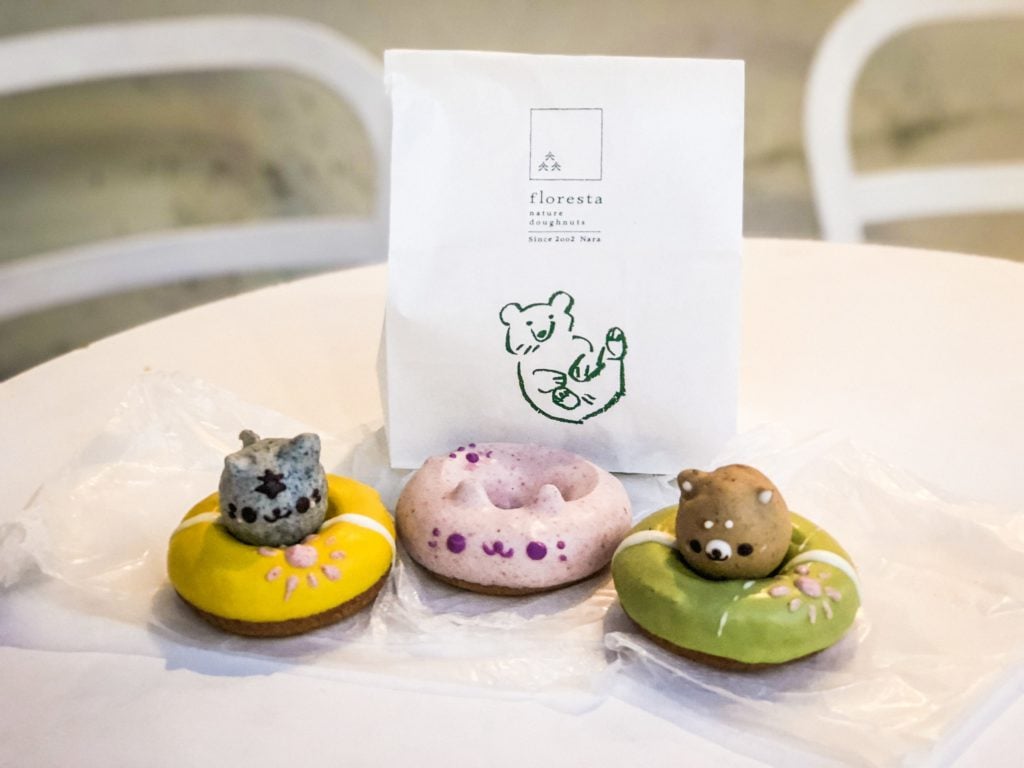
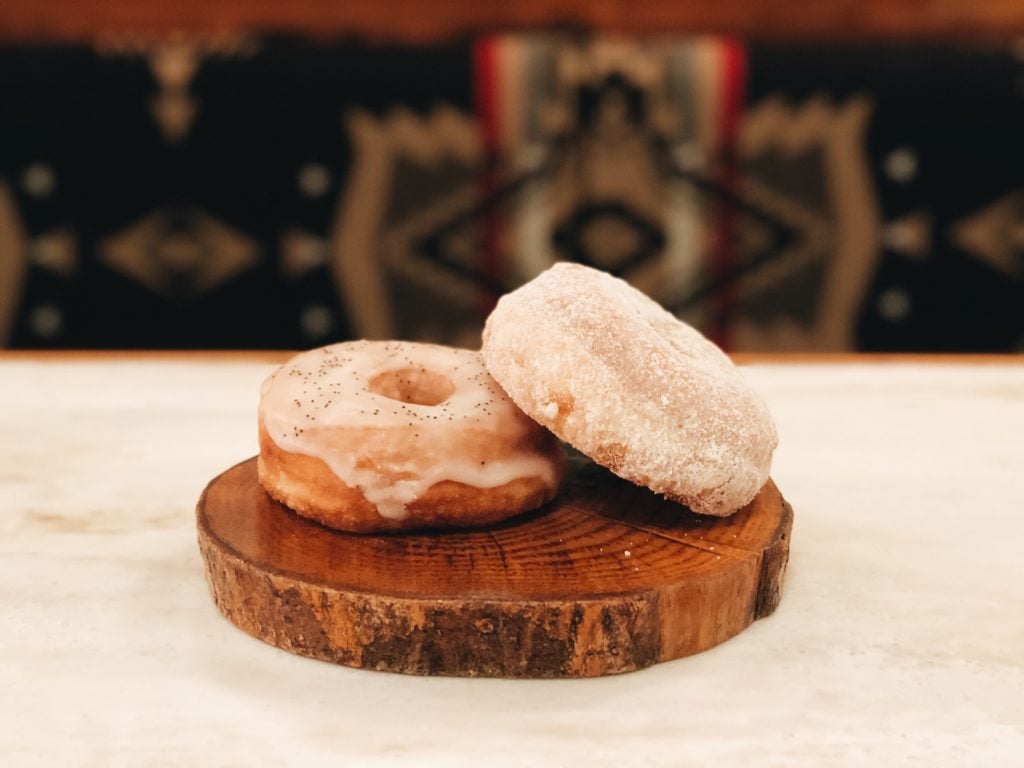
Donuts are a very popular sweet in Japan and although they are less sugary than American donuts you can find them in a variety of styles and flavors like matcha, strawberry, and black sesame. There are even some that are adorably made with cats and bears made out of donut holes!
WHERE TO TRY DONUTS IN JAPAN
- Floresta Nature Donuts – Tokyo
- Good Town Doughnuts – Tokyo (Shibuya)
- I’m Donut? – Tokyo
- Nishiki Market – Kyoto
- Mister Donut – Donut chain all over Japan
Ice Cream (アイスクリーム)
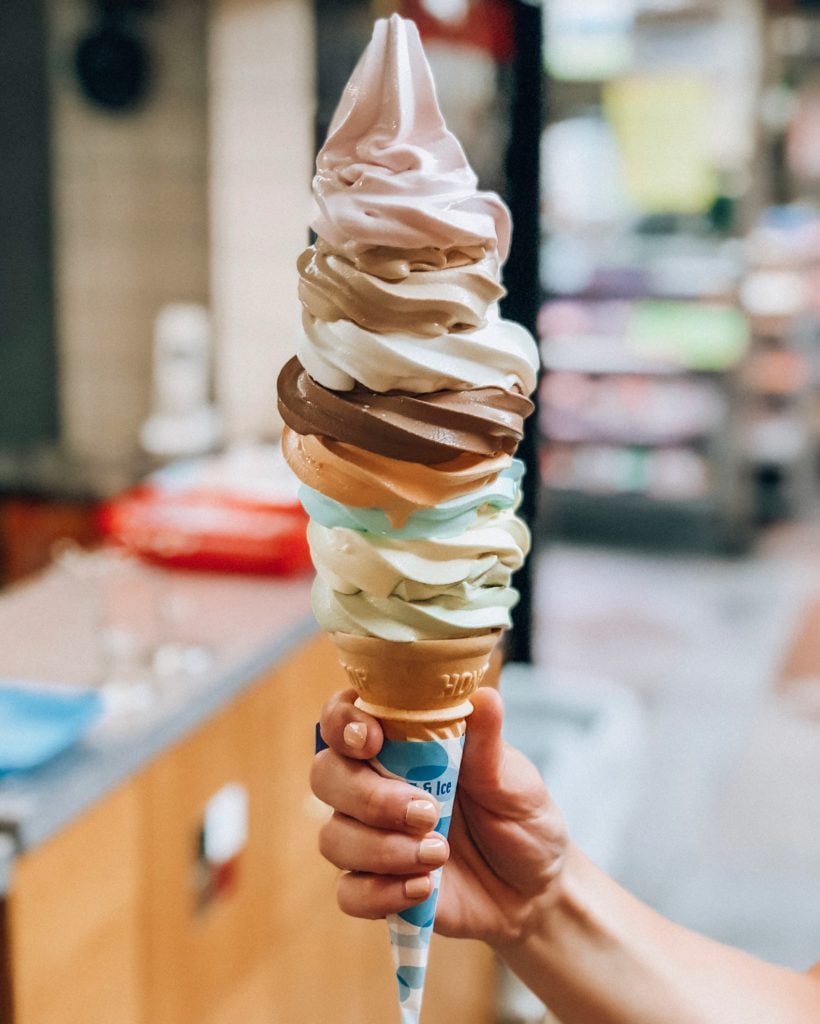
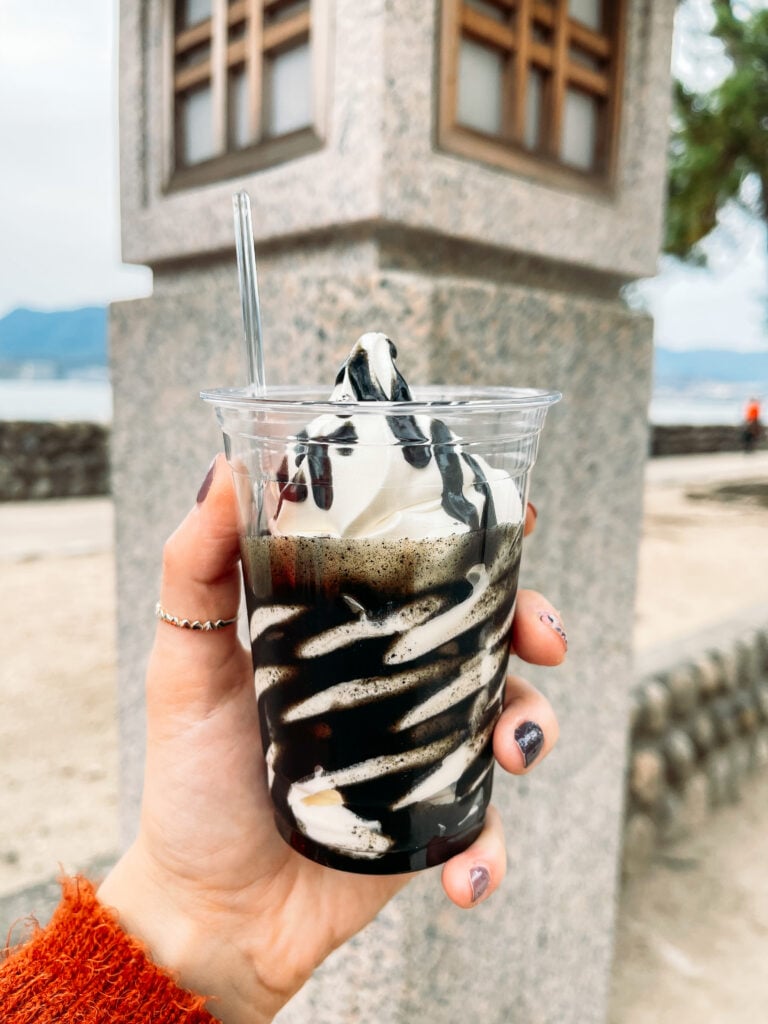
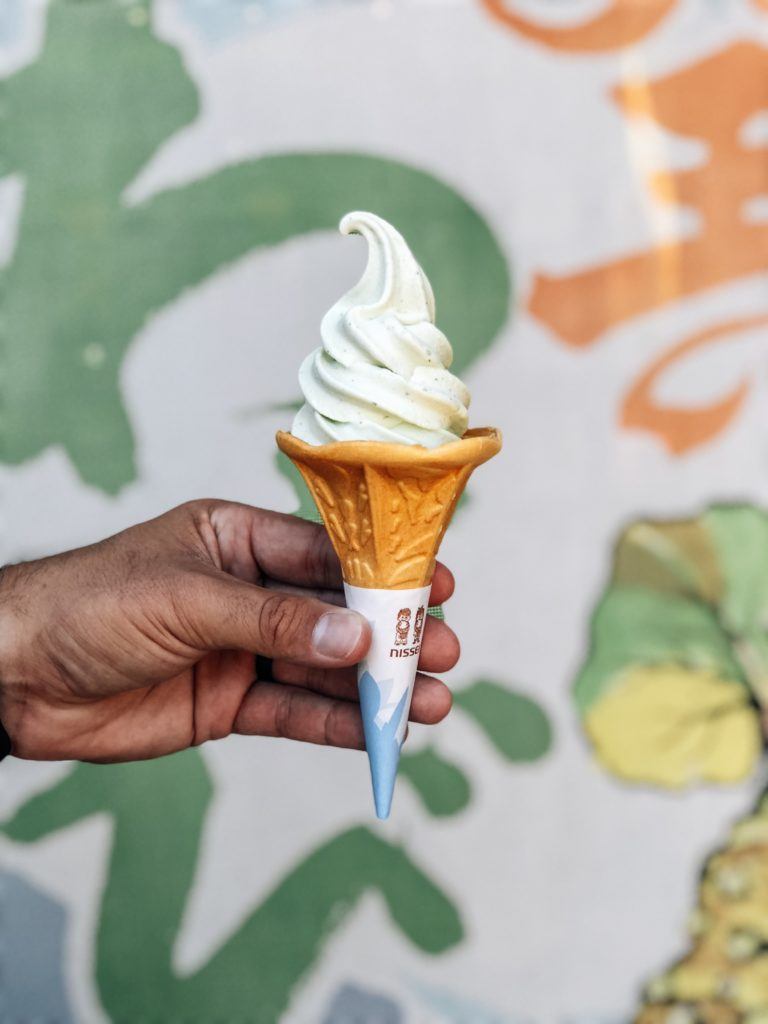
Japanese ice cream is such a favorite of ours we actually wrote a massive guide dedicated to all of the flavors we’ve tried (we’ve had at LEAST 50 different flavors!). Ice cream has become so popular that you can even find unique Japanese flavors like shoyu (soy sauce), tofu, black sesame, miso, and even wasabi!
Parfaits (完璧な)
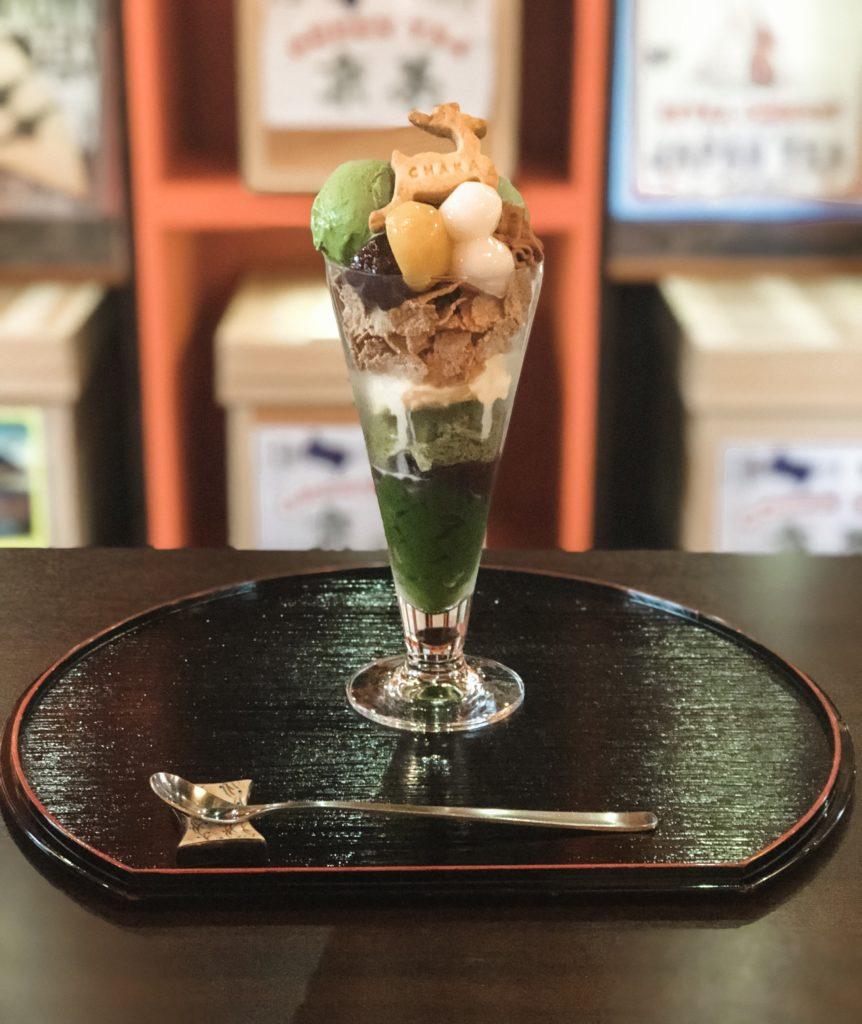
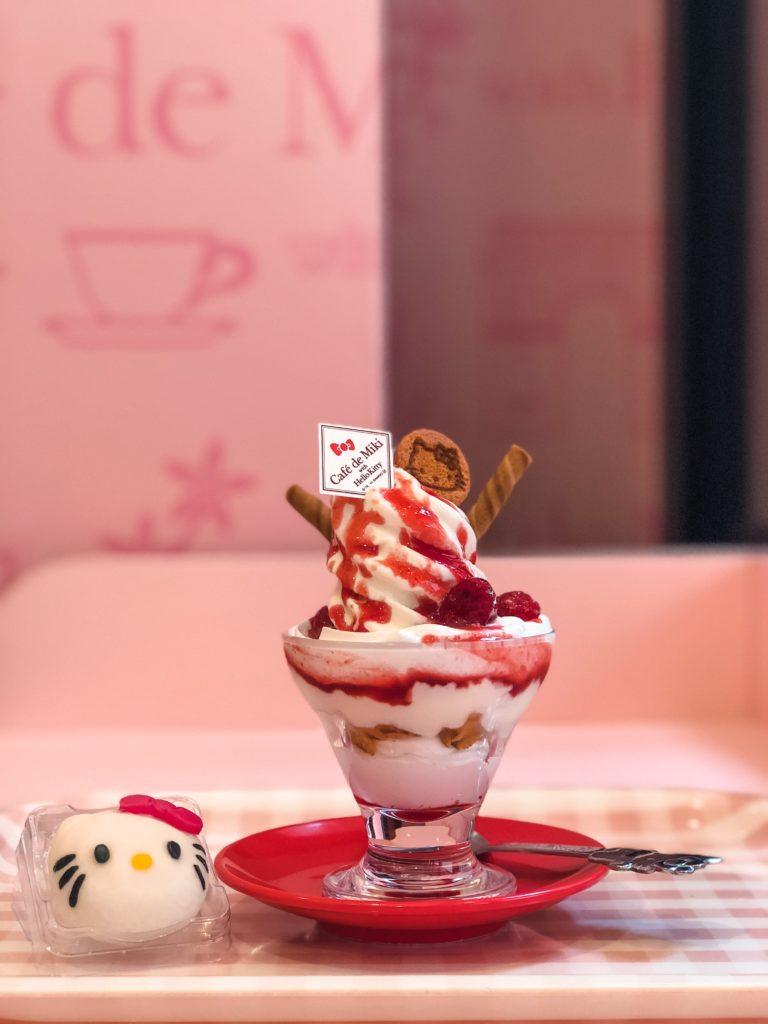
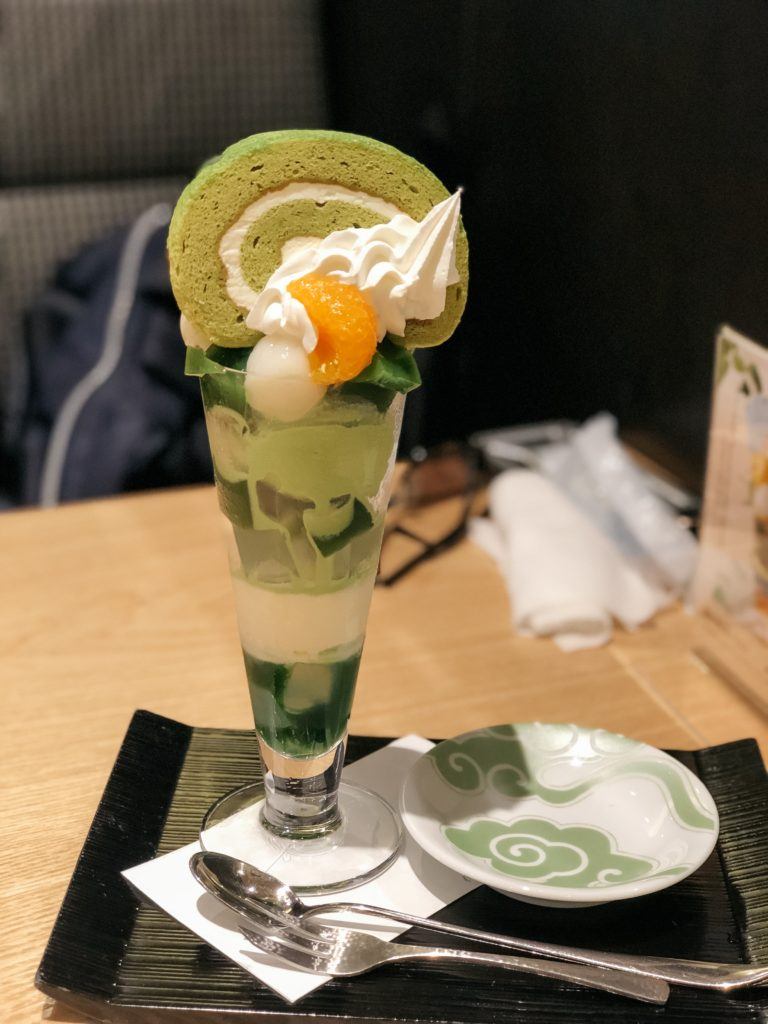
To tag on to ice cream in Japan, parfaits are another widely popular Japanese sweet. There are even cafes completely dedicated to parfaits big and small. We once saw a parfait that was over 10,000 yen (~$100) – to be shared among multiple people of course!
Parfaits in Japan are typically made with layers of cake, ice cream, sweetened cornflakes, fruit, and sometimes flavored jelly. They also occasionally have sweet red bean paste which is a common ingredient for traditional Japanese sweets.
WHERE TO TRY PARFAITS IN JAPAN
- Ito Kyuemon Teahouse – Kyoto
- Karafuneya Coffee – Kyoto
- Cafe de MIKI – Himeji
Kakigōri (かき氷)


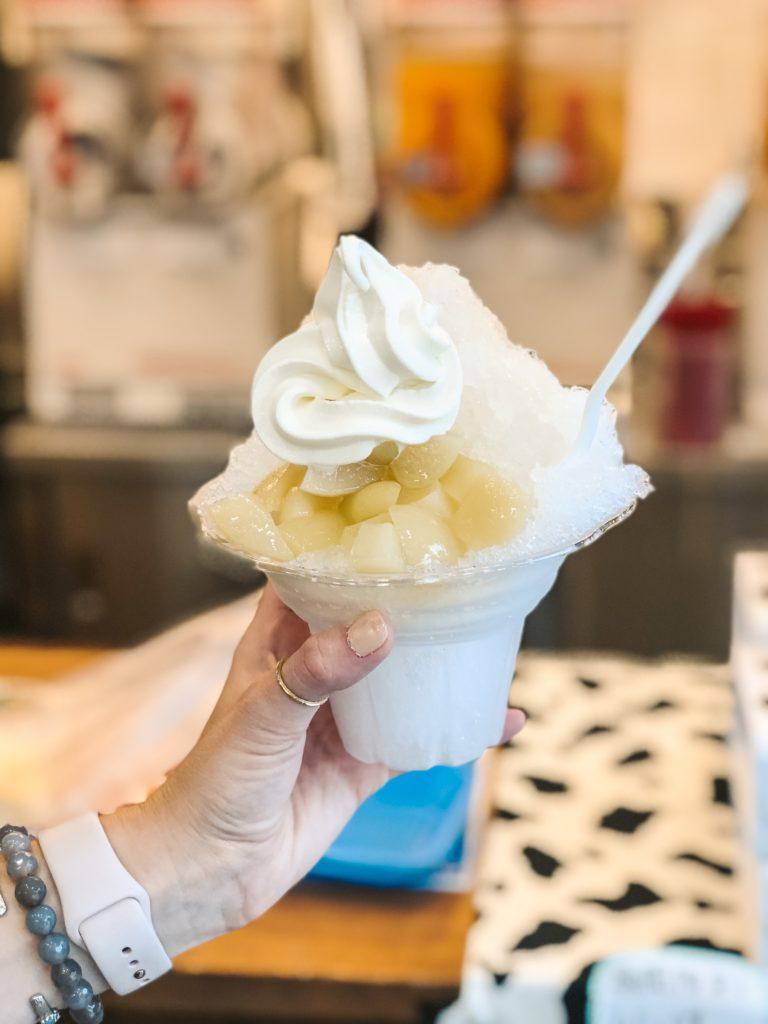
If you happen to visit Japan during the summer you MUST try kakigori. Kakigori is Japanese-style shave ice. The traditional way of making kakigori is by using either a hand-cranked machine or hand-shaving ice blocks of pure mineral water to maintain quality.
Though kakigori is similar to a snow cone, it has a much fluffier texture making it melt in your mouth once it touches your tongue versus the small chunks of ice that you find in snow cones.
Typically you’ll find it in two different styles, Kansai or Kanto based on their respective regional names. In Kansai style kakigori the shave ice is put in a bowl first and the flavoring syrup is added on top.
Kanto-style kakigori is just the opposite where the flavoring syrup is added to the bowl first and then shave ice is added on top. However, even though the names are based on regionality, you can find both kinds all over Japan.
WHERE TO TRY KAKIGORI IN JAPAN
- Asakusa Chakura – Tokyo (Asakusa)
- ICE MONSTER – Tokyo (Omotesando) or Osaka
- Yuki No Shita – Osaka (Umeda)
- cocoo cafe – Osaka
- Nikenchaya – Kyoto
Sweet Crepes (クレープ)

Harajuku in Tokyo, Japan is known for its sweet crepes. When I say sweet, I mean super sweet because of all the desserts in Japan, these might take the cake when it comes to sugar. A lot of sweet crepes in Japan have ice cream or custard with fruit inside but some are even stuffed with whole slices of cheesecake or other cakes AND ice cream!
WHERE TO TRY CREPES IN JAPAN
- Angel Crepes – Tokyo (Harajuku)
- Santa Monica Crepes – Tokyo (Harajuku)
- Dotonbori Crepe – Osaka
Taiyaki (鯛焼き)

Taiyaki is a traditional popular Japanese sweet that is shaped like a fish. To explain it best, it is similar to a waffle batter and is typically filled with sweet red bean paste but you can also find them with sweet potato or custard inside too! They are made on the spot and served piping hot.
WHERE TO TRY TAIYAKI IN JAPAN
- Naruto Taiyaki Honpo – Osaka
- Yanagiya – Tokyo
Purin (プリン)
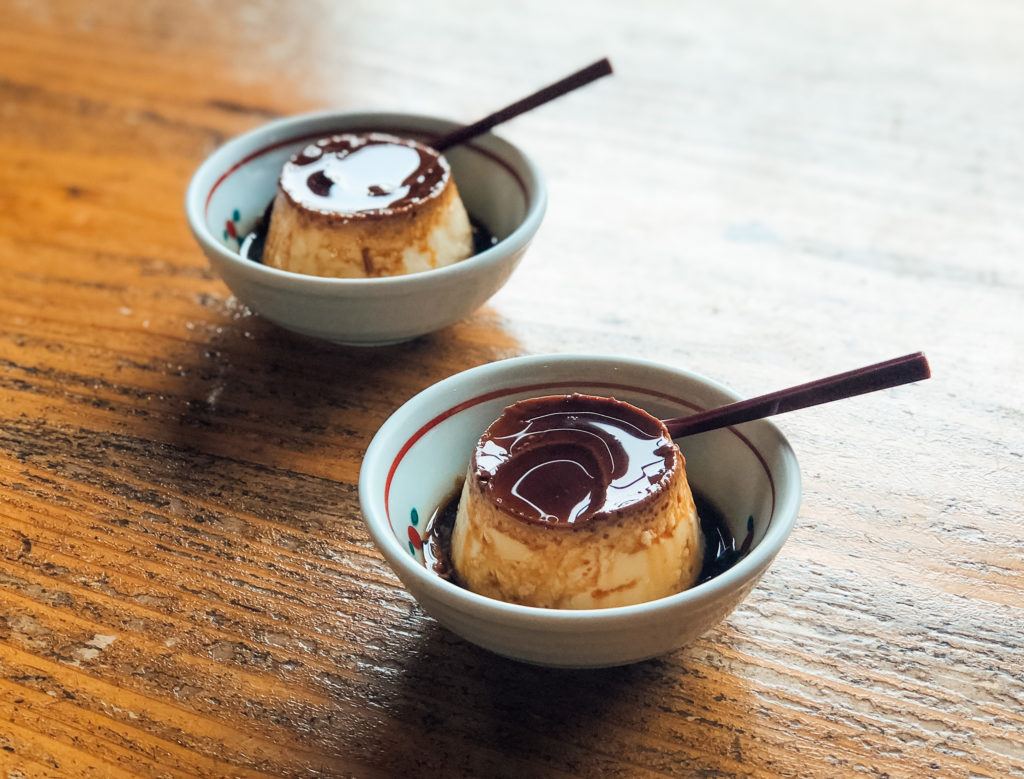
Purin is a custard pudding that you can often find at convenience stores (konbini) like 7-Eleven, Lawson, and FamilyMart in Japan. You might think it looks familiar and that’s because a similar dessert can be found all over the world with different names like crème caramel and flan.
One of the best purin we had while in Japan was in Beppu when we grabbed lunch at Okamotoya Baiten. They are well known all over Japan for making their purin by using the steam from the bubbling hot springs in Beppu!
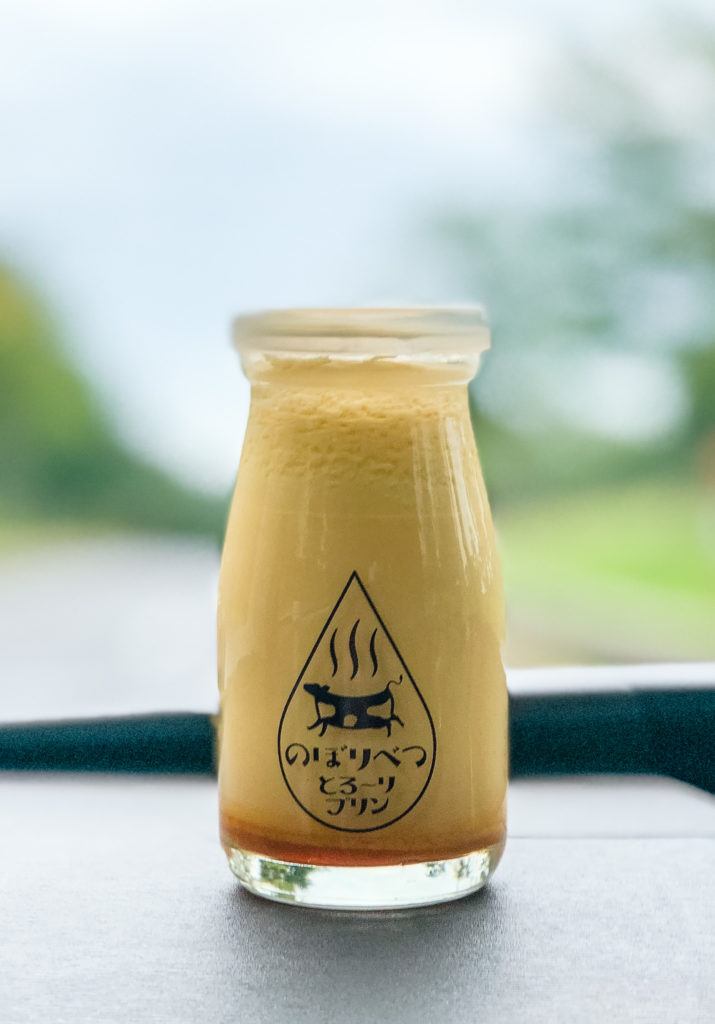
Another time, I bought a small purin in a glass jar at a konbini in Hokkaido. Since Hokkaido is known for dairy products I had to give it a try! It was light, custardy, and had the perfect amount of rich caramel flavor.
WHERE TO TRY PURIN IN JAPAN
- Okamotoya Baiten – Beppu
- Testarossa Cafe – Tokyo
- Konbini (convenience stores) – 7-Eleven, Lawson, & FamilyMart (especially in Hokkaido)
Baumkuchen (バームクーヘン)
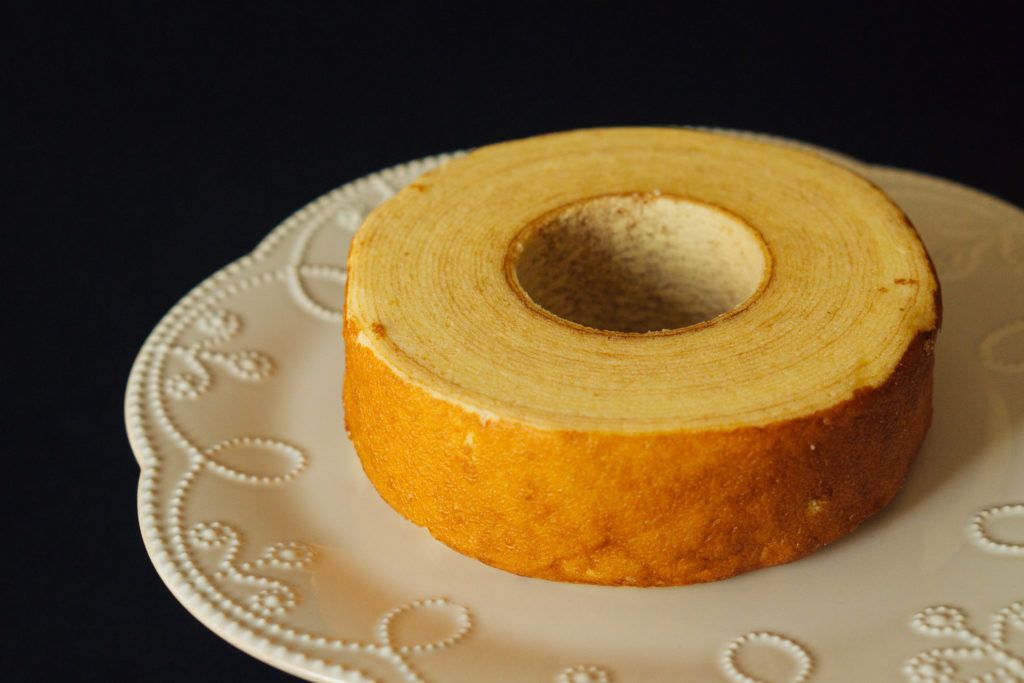
Baumkuchen is a dense sponge cake that literally translates to “tree cake” because the cake is cooked in extremely thin layers on a rotating spit. These layers are thought to resemble the rings on a tree.
Although Baumkuchen is technically German, it has become a very popular Japanese sweet. You can find it all over Japan at Konbini and a few specialty shops in bigger cities as well!
It is most often made with flour, butter, sugar, eggs, and vanilla but some are covered in vanilla or chocolate icing or dusted in sugar. We’ve also had strawberry, matcha, lemon, banana, and orange-flavored Baumkuchen while in Japan.
WHERE TO TRY BAUMKUCHEN IN JAPAN
- Baumkuchen Studio Hachiya – Nikko
- Nenrinya – Tokyo
- ma couleur – Kobe
- Konbini (convenience stores) – 7-Eleven, Lawson, & FamilyMart (especially in Hokkaido)
Japanese Soufflé Cheesecake (スフレチーズケーキ)
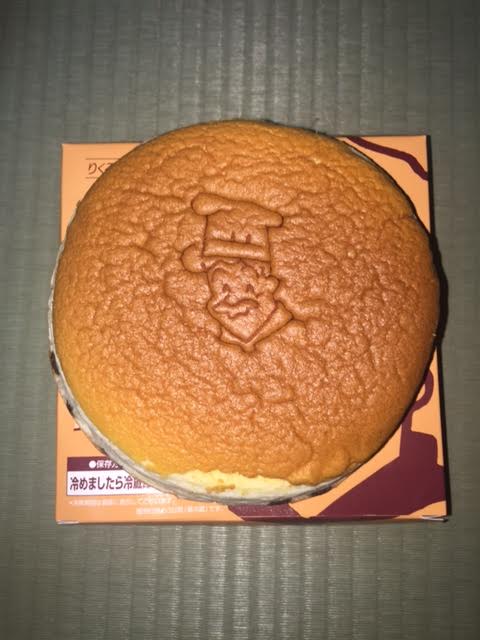
Japanese soufflé cheesecake is unlike any other cheesecake you’ve had – I’m sure of it! It’s kind of a cross between the cheesecake you and I might think of, New York Style or American cheesecake, and a soufflé or sponge cake.
We had our first try of soufflé cheesecake when we were in Osaka. There is a very well-known Japanese cheesecake shop in Dotonbori called Rikuro Ojisan, which translates to Uncle Rikuro.
When we ordered we thought the price seemed a little high for a slice of cheesecake but that’s because we ended up getting an ENTIRE cheesecake for that price.
Did we eat it all? Yes. I mean we had to do our research right? But it’s totally worth it – it’s light, fluffy, and JIGGLES when you shake it. Not that I spent a lot of time doing that and taking boomerangs or anything.
WHERE TO TRY SOUFFLE CHEESECAKE IN JAPAN
- Rikuro Ojisan – Osaka
Wagashi (和菓子)
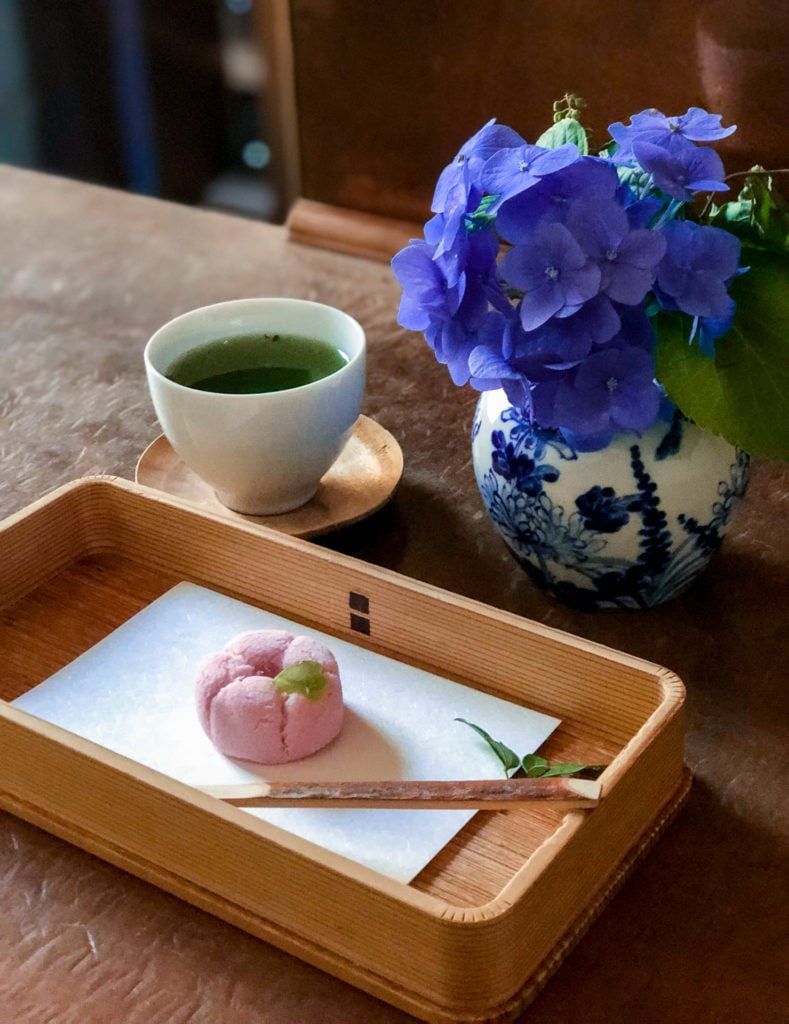
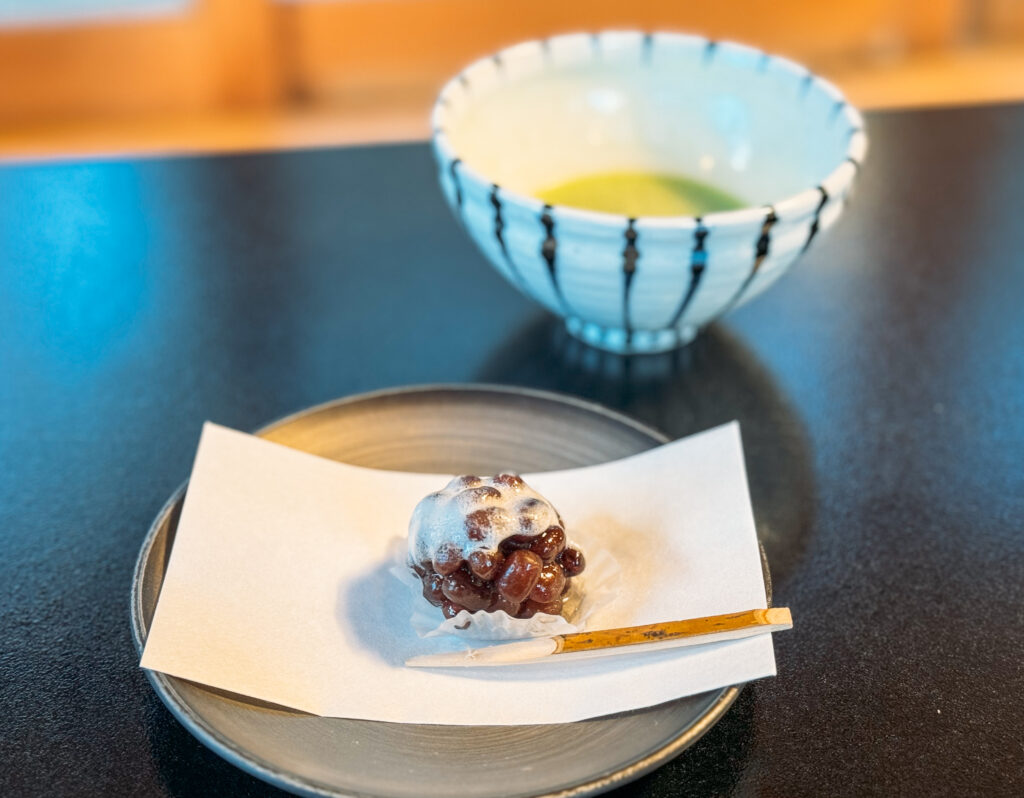
Wagashi consists of many different Japanese confections that are often accompanied by tea. They are typically made from plant ingredients but have a variety of textures, colors, flavors, and preparation methods.

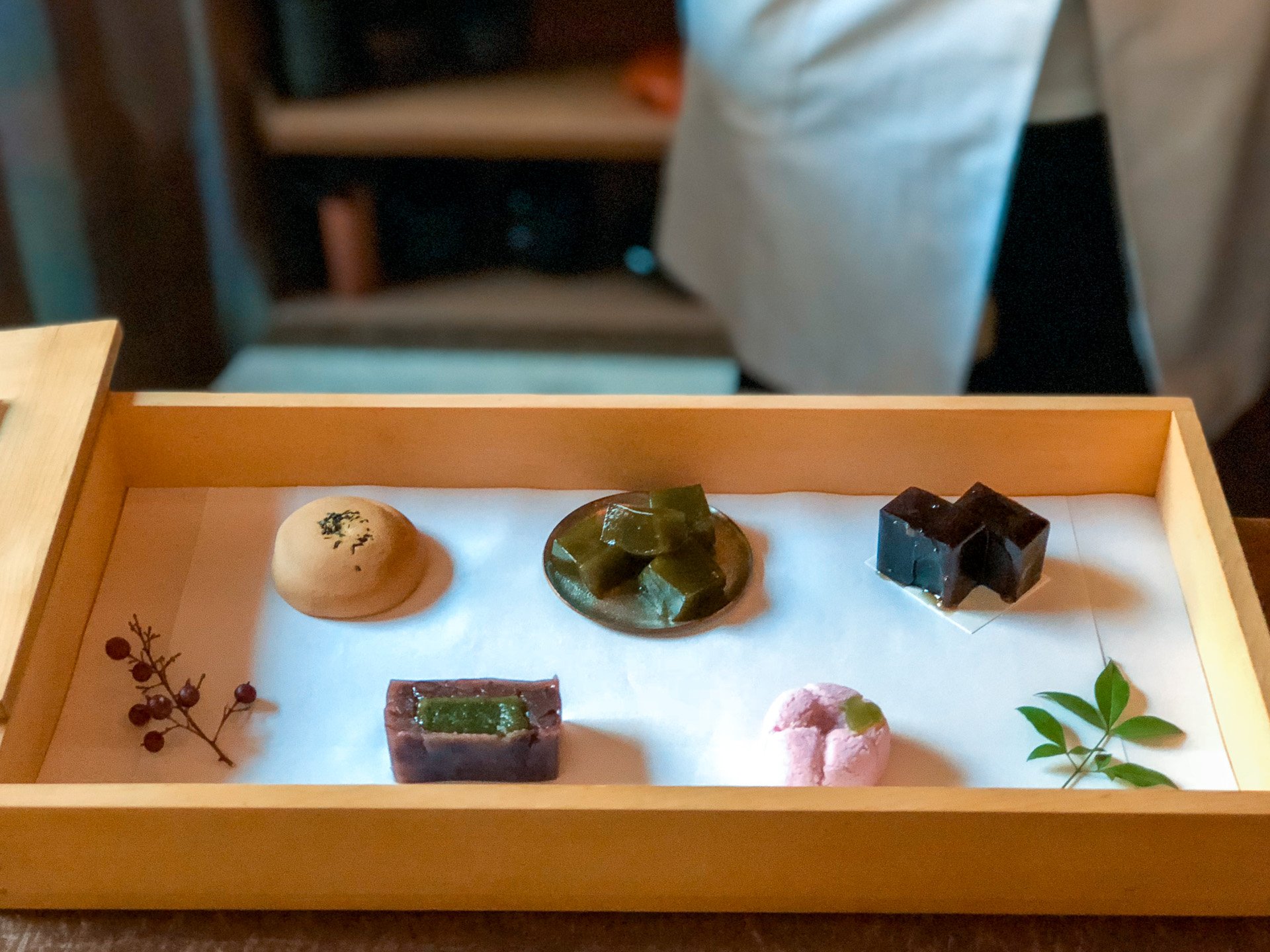
Often, you’ll find seasonally decorated wagashi. For example, sakura in the spring and hydrangea in the summer. These traditional Japanese sweets are the most common. Forewarning – you’ll find that I say “sweet red bean paste” several times in this popular Japanese sweets post. Why? Because it is the most common filling and it’s delicious! Let’s go ahead and look at these Japanese confections now!
Yōkan (羊羹)
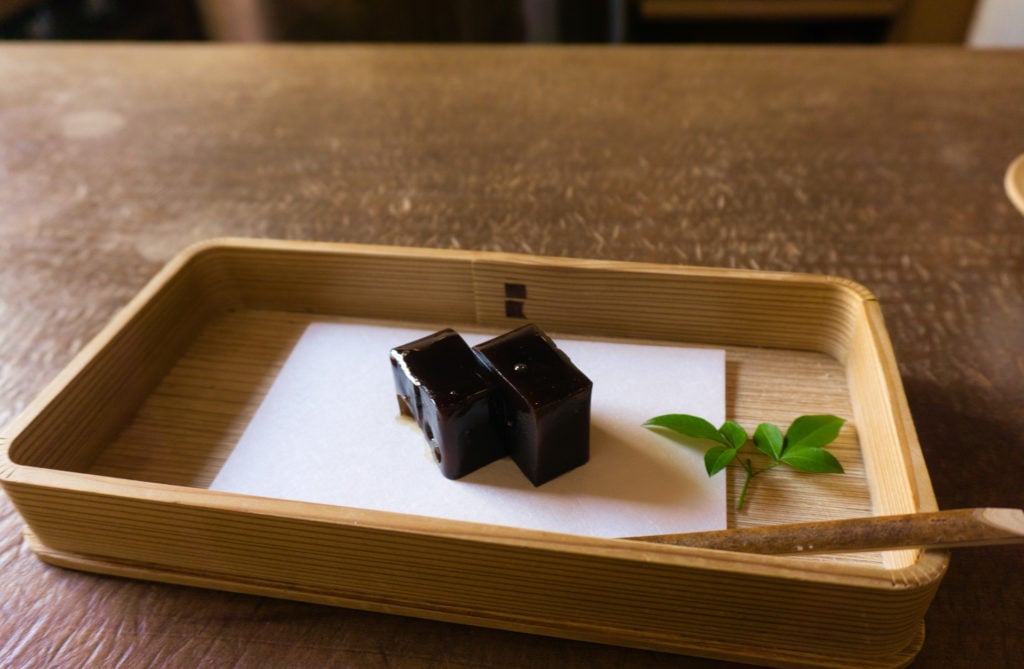
One of my favorites is yōkan (羊羹), a thick, jellied dessert made of red bean paste, agar, and sugar. It is usually sold in a block form and eaten in slices. We’ve had it at wagashi confectionery and tea shops.
One of my favorite experiences from our first trip to Japan was visiting Toraya Ichijo in Kyoto where we were served yōkan with some iced matcha while admiring the beautiful garden view in the rain. The yōkan was complimentary before we tried our first decorative piece of wagashi.
WHERE TO TRY YOKAN IN JAPAN
- Toraya – Kyoto & Tokyo
- Kagizen Yoshifusa – Kyoto
- Higashiya Ginza – Tokyo
Monaka (最中)
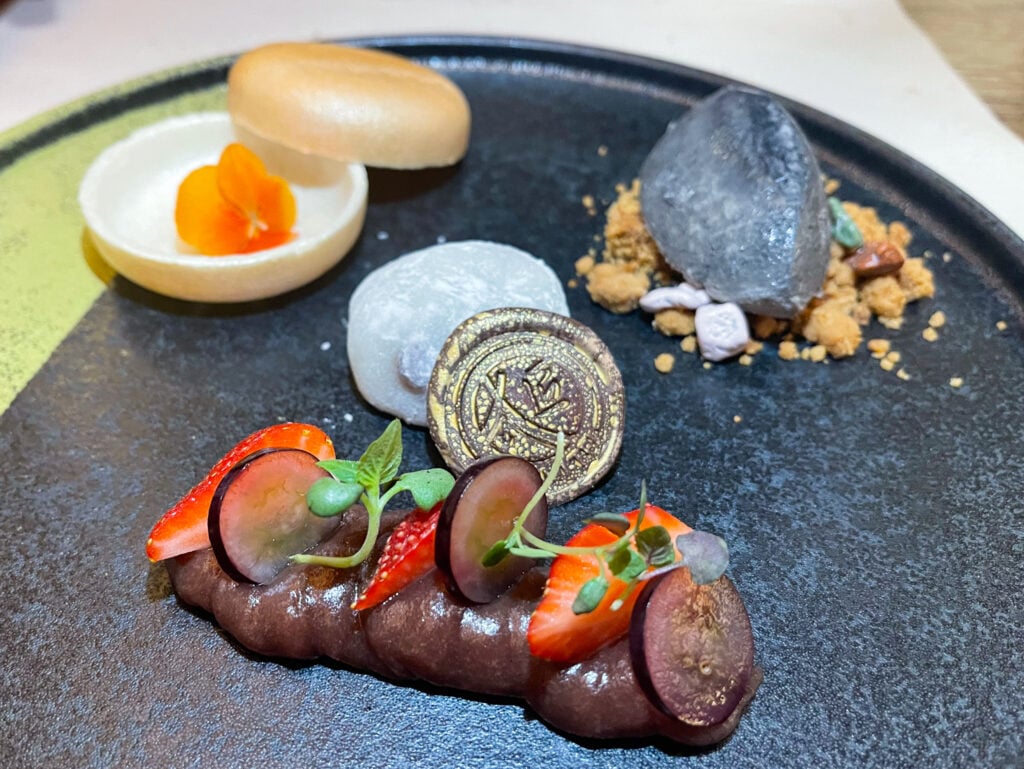
Monaka is a type of wagashi that is made of anko (red bean paste) that can be smooth or chunky and is placed between two thin wafers made from mochi. Individually the wafers don’t have much flavor, but paired with the red bean paste it adds a nice crisp texture.
Dango (団子)

Now onto one of my favorites, dango! Which you might recognize from the iPhone emoji. Dango is a round dumpling that is made from sweet rice flour. It is served on a skewer that typically has anywhere from 3-5 dango.
You can find this traditional sweet year-round in Japan, but the type of dango served is often based on seasonality. There are many different types of dango in Japan but we’ll cover the most commonly found and our favorites.
CHADANGO (茶団子)
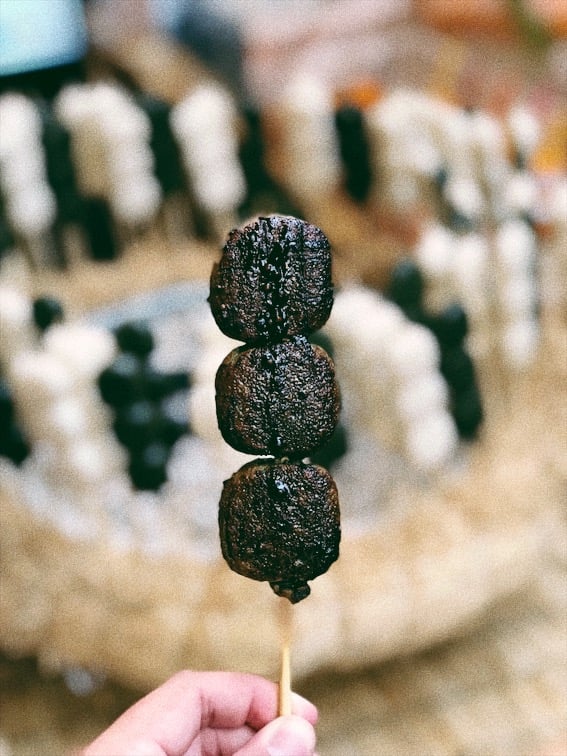
Chadango is a green tea-flavored dango. I’ve only had it grilled with a sweet and salty soy sauce glaze (also called yakidango) but the flavor of the green tea is very subtle.
BOTCHAN DANGO (坊っちゃん団子)
Botchan dango isn’t one we’ve commonly found in Japan but we did find it while we were in Matsuyama, where it is well-known. It has three colors – red, made with red bean paste, yellow, made with egg, and green which is made with green tea. Again, the flavors are very subtle.
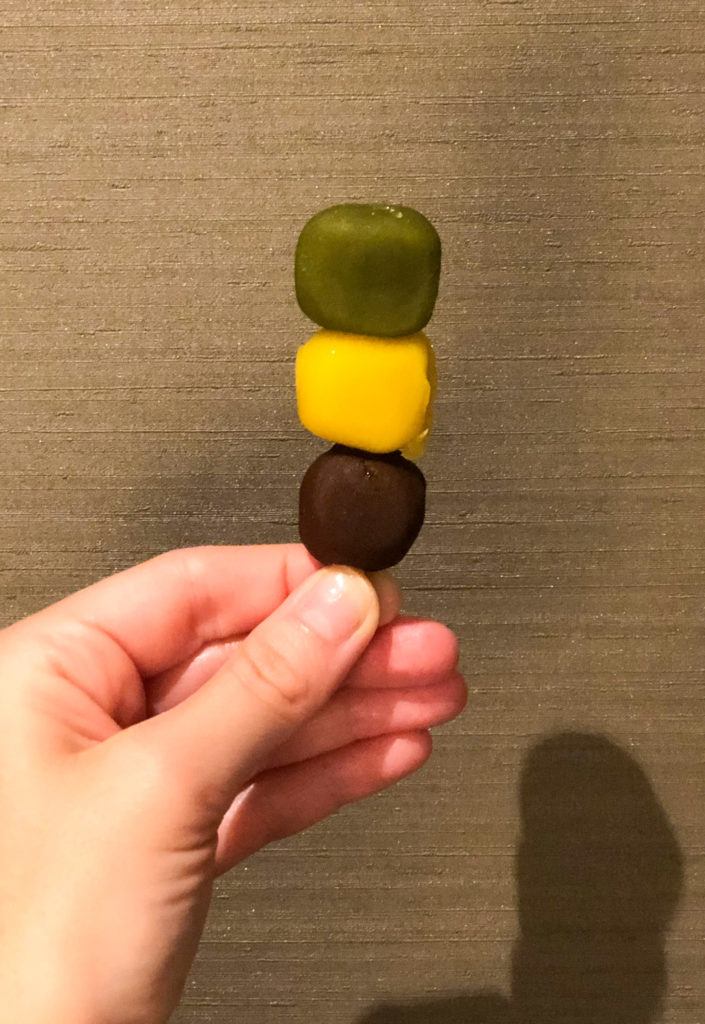
HANAMI DANGO (花見だんご)
Hanami dango is one of the most recognizable in Japan. Like botchan dango, it also has three colors and is usually made during Sakura season, hence the name “hanami” meaning “flower viewing.”
The three colors are green, to represent the color of young grass, white, to symbolize the past fallen snow, and pink, to represent the cherry blossom flowers.

KIBI DANGO (きび団子)
Kibi dango is made with millet flower and then coated with a kinako, a toasted soy powder that tastes similar to a roasted peanut powder. This one is very similar to kinako dango except kinako dango is made with sweet rice flour.
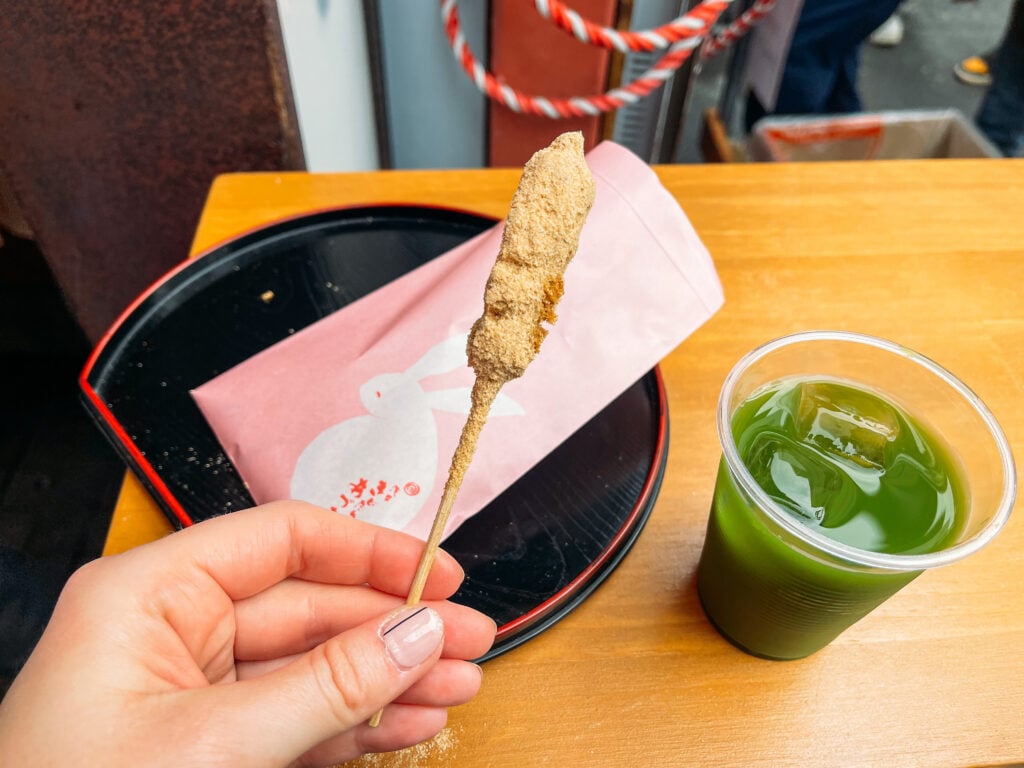
MITARASHI DANGO (みたらし団子)
Mitarashi dango is a more sweet and salty type of dango. It is covered with a sticky sauce made from shouyu (soy sauce), sugar, and starch and is lightly grilled.
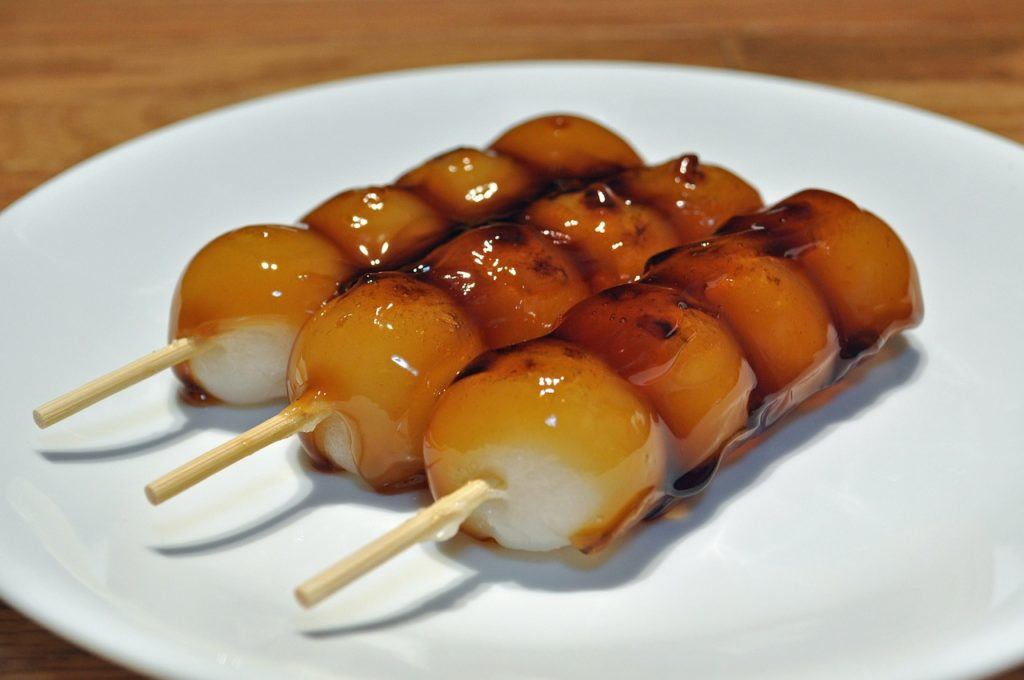
ANKO DANGO (あんこ団子)
Anko dango is covered with sweetened red bean paste. Although anko is most commonly used, you can also find other toppings regionally including black sesame paste, zunda (edamame paste), and kurumi (walnut paste).
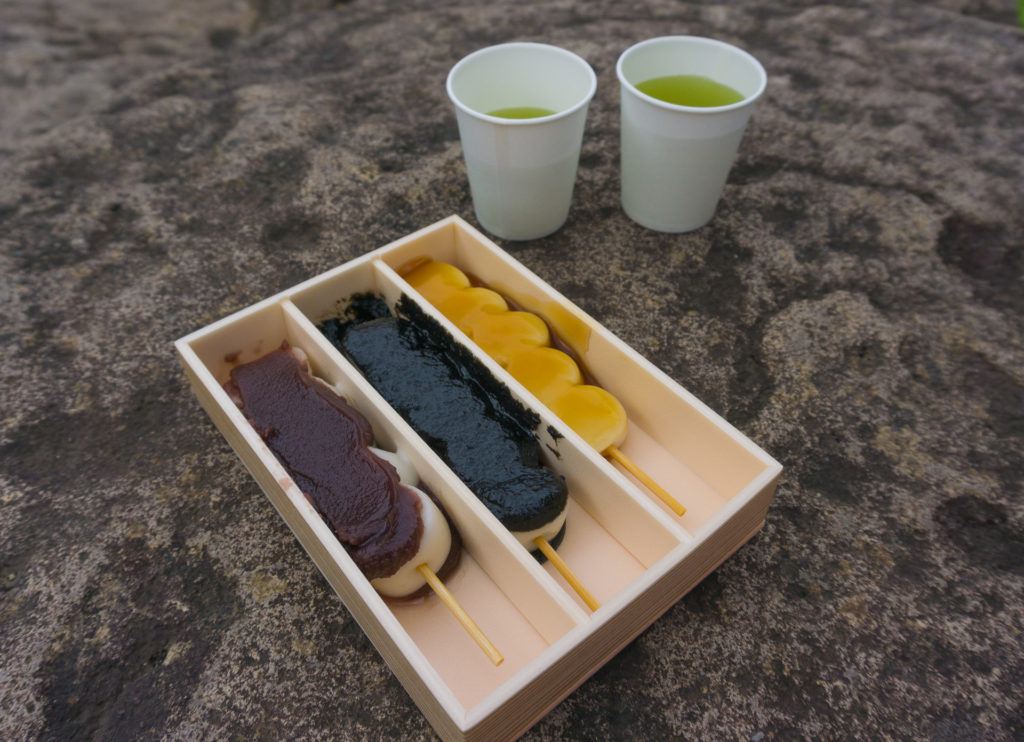
WHERE TO TRY DANGO IN JAPAN
- Habutae Dango – Tokyo
- Genbeki Gorge – Ichinoseki
- Kuramon Market – Osaka
- Nishiki Market – Kyoto
- Japanese grocery stores
- Konbini (convenience stores) – 7-Eleven, Lawson, FamilyMart
Mochi (餅)
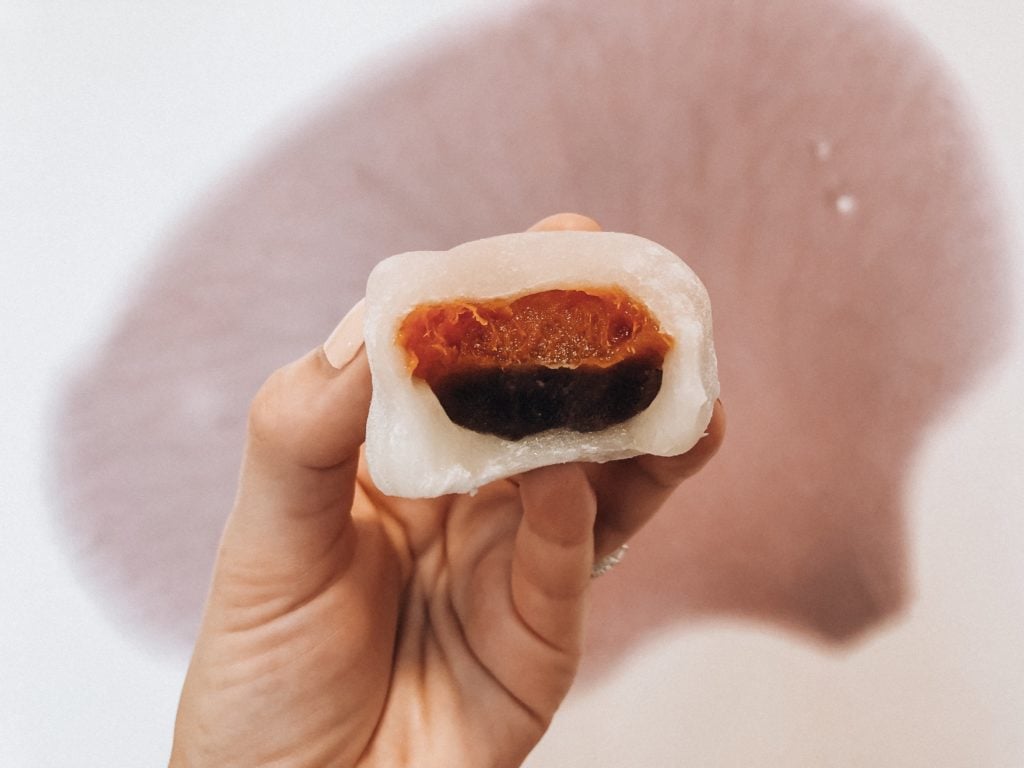
Similar to dango, mochi is another Japanese dessert that is made with sweet rice. The big difference is that mochi is made with intact grains of rice that are pounded repeatedly while dango is made with sweet rice flour. The size of mochi is also much larger than the size of dango and it is typically not served on a skewer.
ABURI MOCHI (あぶり餅)
I know, I know. Right after I tell you that mochi isn’t typically on a skewer I give you aburi mochi, one exception. The only place I’ve ever had memorable aburi mochi is from a small shop called Ichiwa in Kyoto. I love it so much I still salivate when I see photos of it.
Now, there is another aburi mochi shop across the street that does look similar but they are rivals – like the Capulets and the Montagues from Romeo and Juliet. So I didn’t dare cross the street to give it a try when we visited Ichiwa. Okay, I will say their rivalry is definitely more playful than the families of the star-crossed lovers.
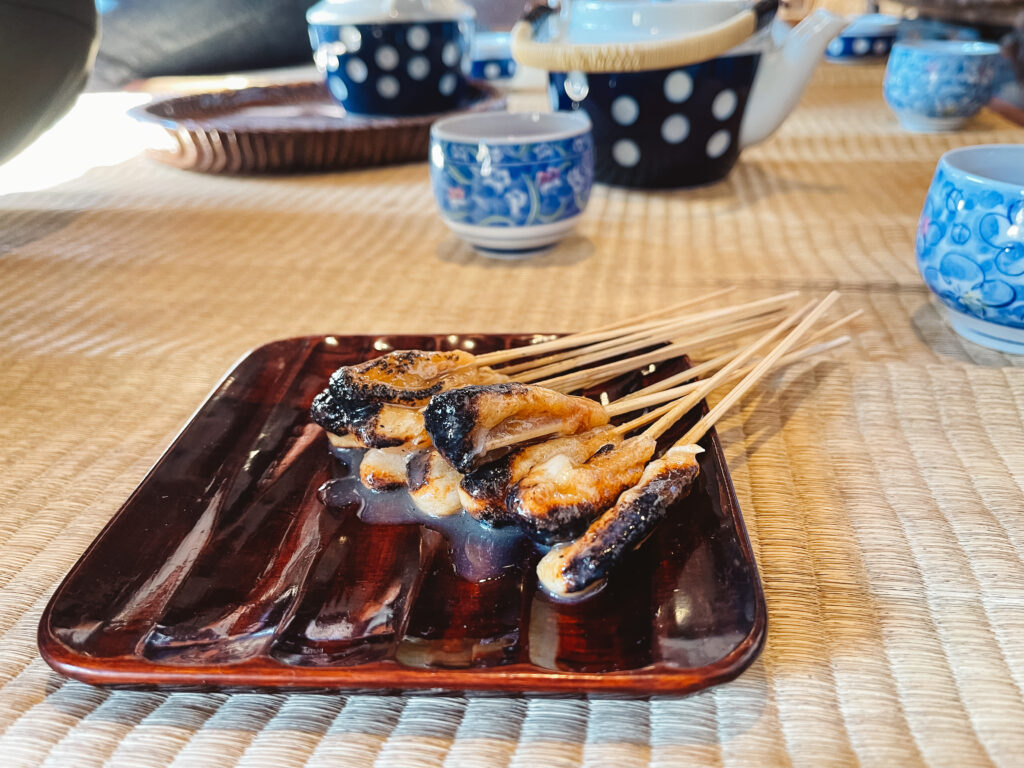
KINAKO MOCHI (きなこ餅)
Like kinako dango, kinako mochi is just larger sweet rice dumplings dusted in soybean powder. This particular kinako mochi I bought from Nakatanidou in Nara, Japan.
Nakatanidou is known for its “pounding mochi show” where they pound the rice vigorously right before your eyes to make their mochi. Their mochi is green tea flavored, filled with sweet red bean, and covered in a dusting of kinako powder. If you’re lucky, watch the show and grab one while it’s still warm!
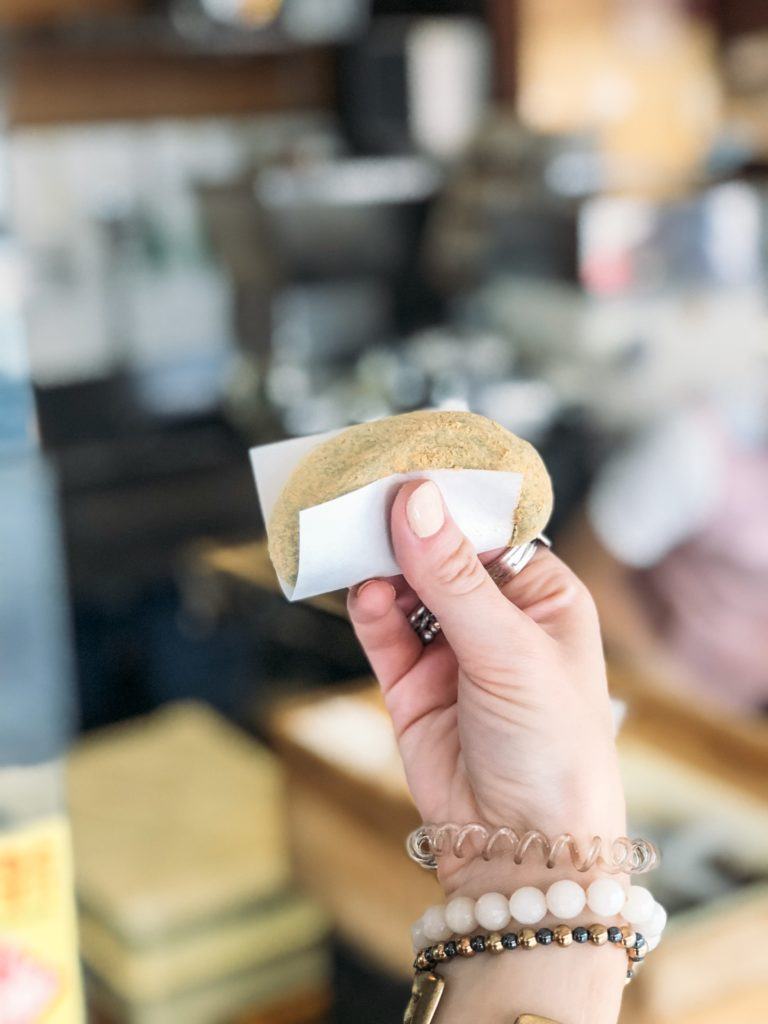
YATSUHASHI MOCHI (八橋)
Yatsuhashi is a regional type of mochi that you can find in almost every souvenir shop in Kyoto. It is a triangular-shaped mochi made with glutinous rice flour, sugar, and filled with sweet red beans.
BOTA MOCHI / OHAGI (ぼたもち or 牡丹餅)
Bota mochi (or ohagi) is daifuku turned inside out. Instead of the paste being on the inside of the mochi, in bota mochi, the filling is on the outside of the rice cake. This type of mochi can be found at konbini occasionally but it is most commonly found around Ohigan, a Buddhist holiday in the spring and autumn.
WARABI MOCHI (わらび餅)
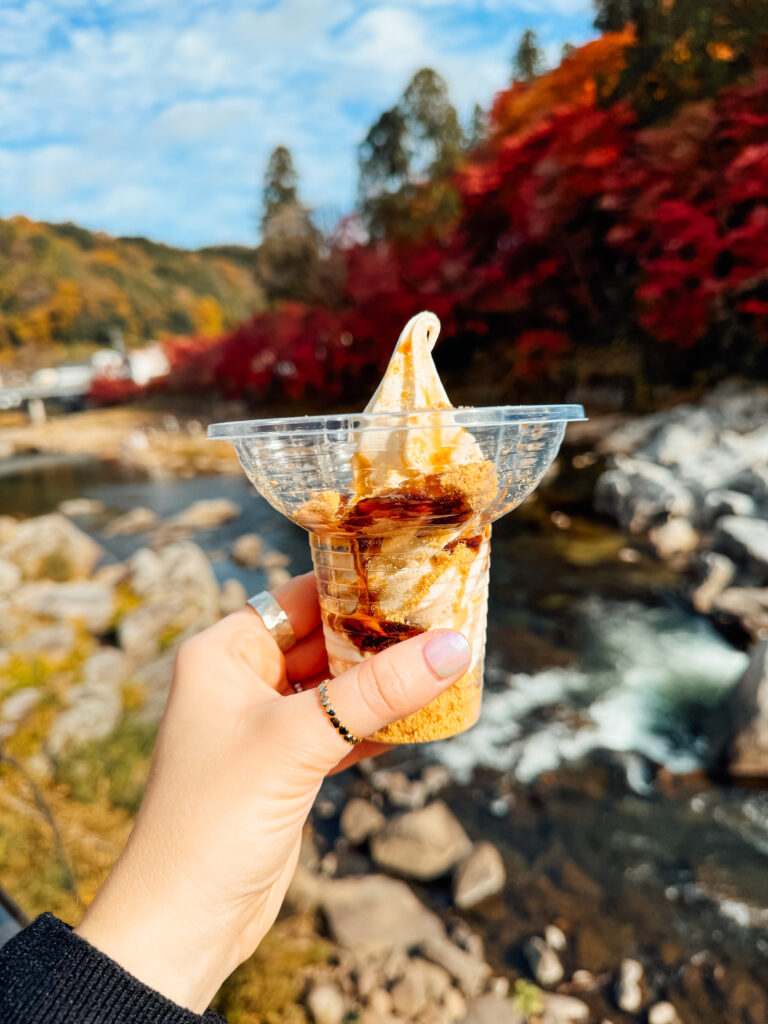
Warabi mochi is slightly different from typical mochi because it is made from bracken starch rather than rice flour. It has a jelly-like consistency and then rolled in kinako (roasted soybean powder), and then drizzled with kuromitsu (black sugar syrup).
GOHEI MOCHI (五平餅)
Gohei mochi is a popular regional mochi located primarily in the Chubu region. It is a flattened rice cake on a stick that is grilled and covered with a paste made of miso and walnuts.

DAIFUKU (大福)
Daifuku is a type of mochi that could honestly have its own category because there are so many types! It is filled with a lightly sweet filling, most commonly a sweet red bean paste and sometimes fruit as well! It is typically coated in a starchy substance like potato flour or kinako (soybean powder) to prevent it from sticking making it easier to eat.
Ichigo daifuku (イチゴ大福) is one of my favorites and it can be hard to find because of seasonality! This type of daifuku usually is filled with a thin layer of sweet red bean paste and a fresh strawberry. The flavors together are perfectly balanced and not overpowering.
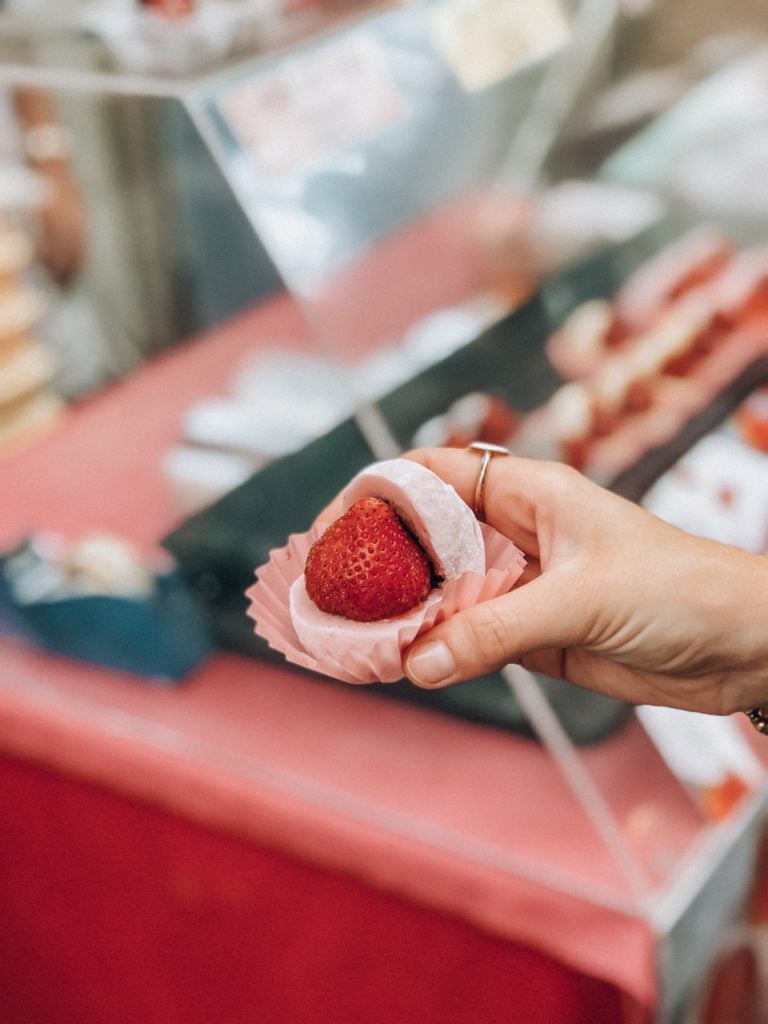
WHERE TO TRY MOCHI IN JAPAN
- Nakatanidou – Nara
- Ichiwa – Kyoto
- Nishiki Market – Kyoto
- Kuramon Market – Osaka
- Konbini (convenience stores) – 7-Eleven, Lawson, FamilyMart
- Japanese grocery stores
Manju (饅頭)
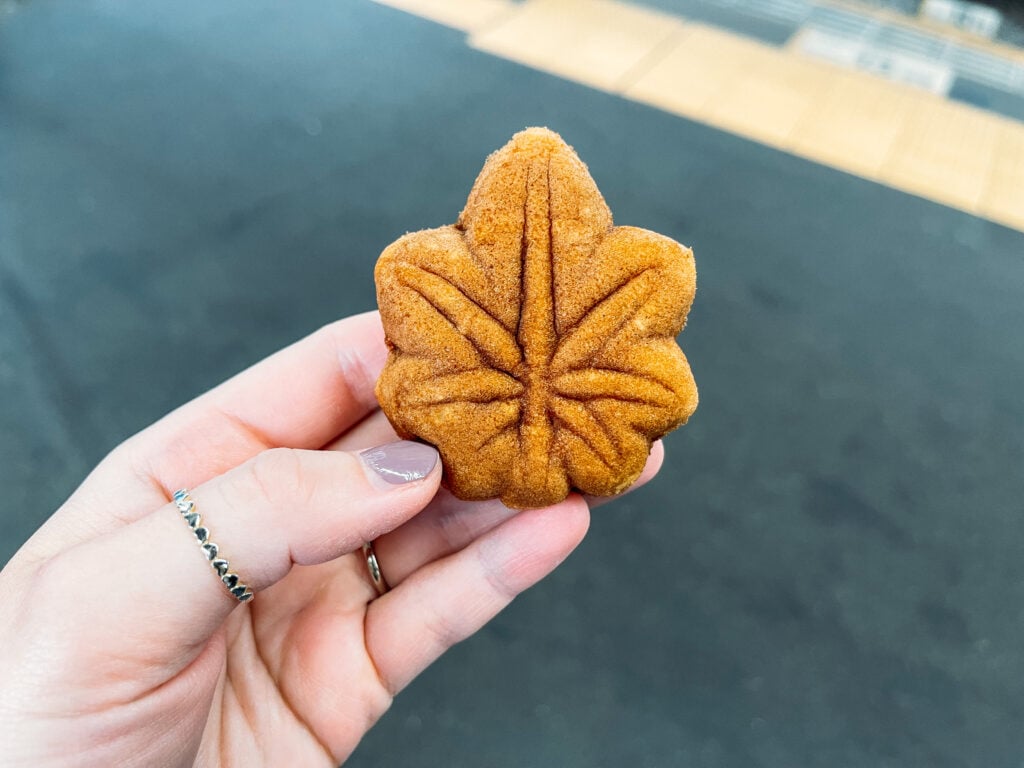
Manju is another traditional Japanese confection. It is similar in size and shape to mochi but is made from traditional flour, rice powder, arrowroot, and buckwheat flour to make a dense cake on the outside and filled with anko, sweet red bean paste on the inside, or occasionally chestnut paste in the autumn months.
WHERE TO TRY MANJU IN JAPAN
- Miyajima Island (Known for their manju shaped like a maple leaf)
- Fujito Manju – Okayama
- Nishiki Market – Kyoto
- Kuramon Market – Osaka
- Konbini (convenience stores) – 7-Eleven, Lawson, FamilyMart
- Japanese grocery stores
Dorayaki (どらやき)
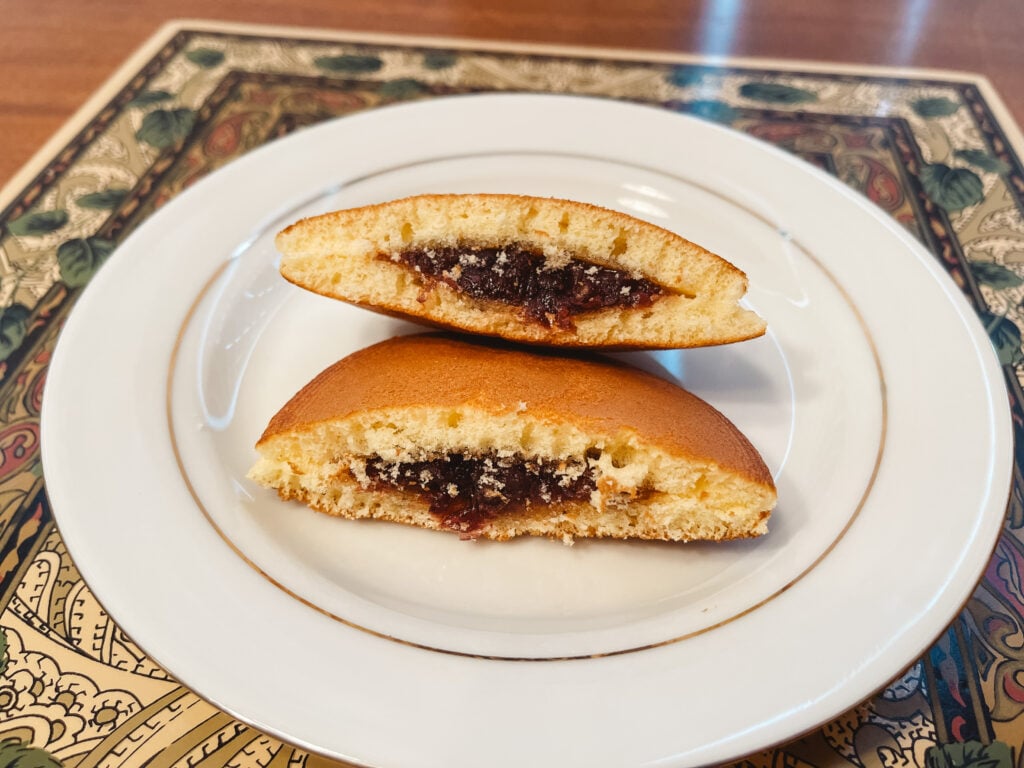
Dorayaki is a set of two small pancakes made from castella, a dense sponge cake, and filled with sweet red bean paste. There is a legend that the first dorayaki was made by accident when a samurai forgot his gong (dora) when leaving from a farmer’s house he was hiding in. The farmer later took the gong and used it to make pancakes and stuffed them with sweet red bean paste.
WHERE TO TRY DORAYAKI IN JAPAN
- Usagiya – Tokyo (Ueno)
- Mikasa – Kyoto (Gion)
- Konbini (convenience stores) – 7-Eleven, Lawson, FamilyMart
- Japanese grocery stores
Konpeitō (金平糖)
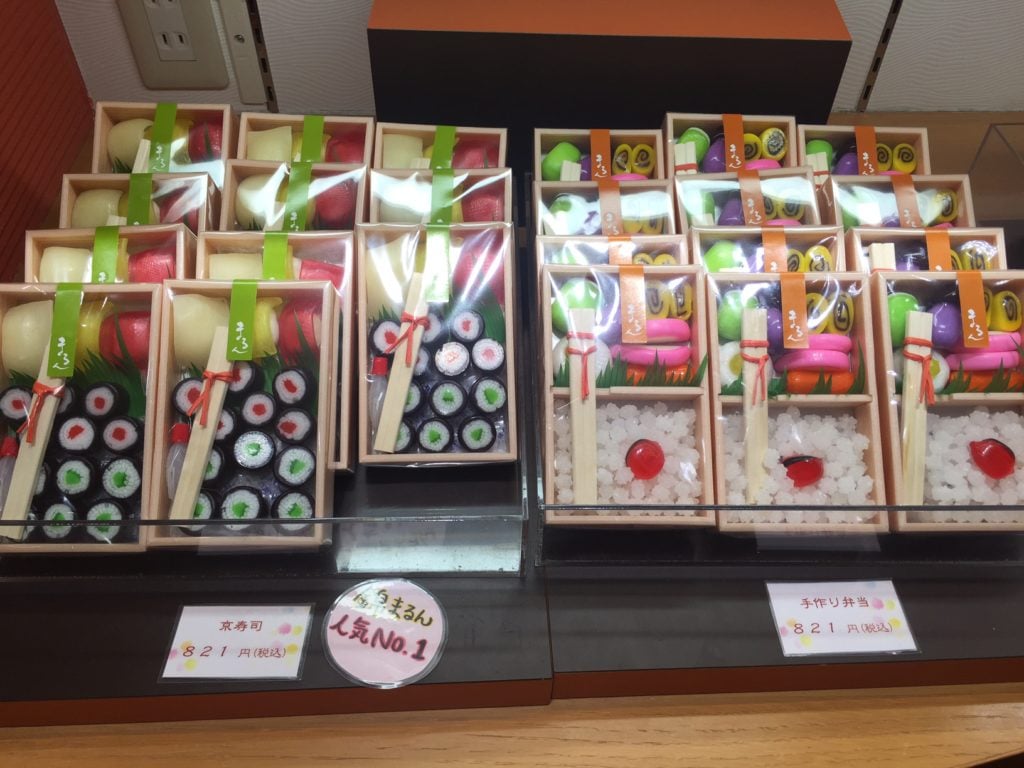
Konpeitō is a Japanese sugar candy that was originally introduced by Portuguese traders in the 16th century. It is handmade by heating a lump of sugar and then adding liquid sugar in small droplets little by little. It can take up to TWO WEEKS to complete just one of these tiny sugar candies and years to master the skills needed to make them.
I won’t lie, I had no idea the time, effort, and skills needed to make these tiny sugar candies and honestly took them completely for granted when I first tried them thinking they must be made in a big factory – boy was I surprised! Oh konpeitō, I’ll never take you for granted again!
Konpeitō is commonly found in souvenir shops and we’ve also seen them in Nishiki Market in Kyoto! It comes in a variety of flavors like peach, strawberry, cherry, and some unique flavors like chestnut, plum, and yuzu, a type of Japanese lemon.
WHERE TO TRY KONPEITO IN JAPAN
- Nishiki Market – Kyoto
- Kuramon Market – Osaka
Amezaiku (飴細工)
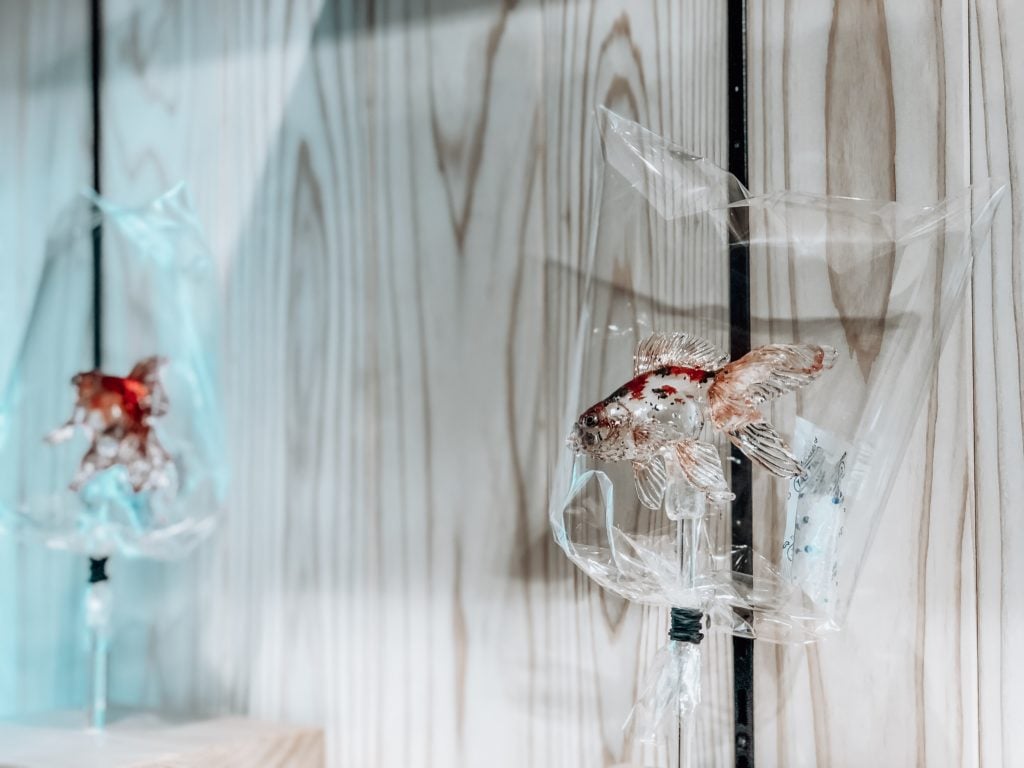
The last Japanese confection we’ll include in this guide to Japanese sweets and desserts is amezaiku. Although a candy, amezaiku could also be considered to be an art form like glass blowing. Artists use their hands, a variety of tools, and heat to pinch, stretch, clip, and pull to form the main structure.
While we were in Tokyo we visited an amezaiku shop that sold these beautiful candies but also offered a class to learn how to make them! We didn’t have time when we were there, but it’s definitely something we’re adding to our list for next time!
WHERE TO TRY AMEZAIKU IN JAPAN
- Asakusa Amezaiku Ameshin – Tokyo
Which of these popular Japanese sweets would you want to try first?
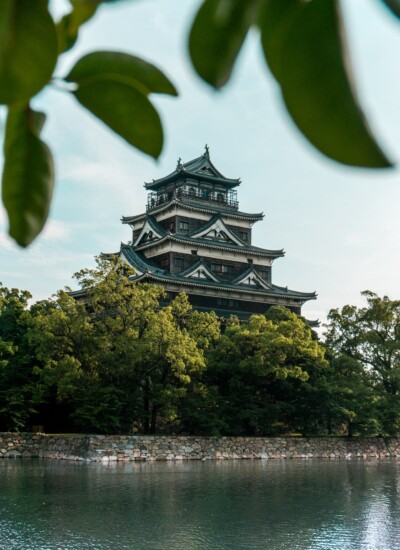


Leave A Reply!